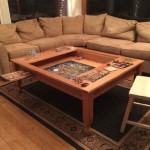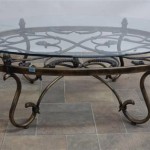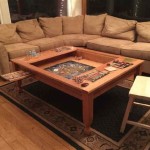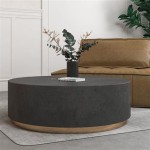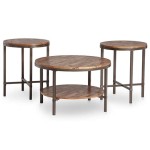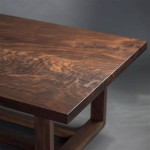```word ## How To Find The Center Of A Circular Table Top
Determining the precise center of a circular table top is a common challenge encountered in various contexts. This task arises in woodworking, furniture making, design projects, and even when setting up a table for aesthetic purposes. Accurate center location is crucial for mounting hardware, creating symmetrical designs, or ensuring even weight distribution. Several methods exist for finding the center, each offering varying degrees of accuracy and complexity. This article will detail several proven techniques, providing a comprehensive guide for locating the center of a circular table top.
The importance of accurately locating the center cannot be overstated. An off-center hole for a table leg, for instance, can lead to instability and an aesthetically displeasing result. Similarly, an imprecisely marked center for a decorative inlay may result in an unbalanced and unprofessional appearance. Therefore, understanding and applying the methods outlined below is essential for achieving professional-quality results in any project involving a circular table top.
Method 1: The Perpendicular Bisector Method
The perpendicular bisector method leverages fundamental geometric principles to accurately determine the center of a circle. This method relies on the fact that the perpendicular bisector of any chord of a circle passes through the center of that circle. By constructing two such bisectors, their intersection point will define the circle's center.
Step 1: Draw the First Chord. Using a straight edge or ruler, draw a straight line across the surface of the circular table top. This line, known as a chord, should ideally be drawn near the edge of the circle for greater accuracy. The length of the chord is not crucial, but a longer chord generally simplifies the subsequent steps.
Step 2: Construct the Perpendicular Bisector of the First Chord. The perpendicular bisector is a line that intersects the first chord at its midpoint and forms a 90-degree angle with it. There are several ways to construct this bisector.
Step 2a: Using a Compass. Place the compass point on one end of the chord and open the compass to a width slightly longer than half the length of the chord. Draw an arc that extends both above and below the chord. Repeat this process with the compass point on the other end of the chord, ensuring that the radius (compass opening) remains the same. The two arcs will intersect at two points. Using the straight edge or ruler, draw a line connecting these two intersection points. This line is the perpendicular bisector of the first chord.
Step 2b: Using a Ruler and Square. Measure the length of the first chord and divide by two to find the midpoint. Mark this midpoint on the chord. Align a square (such as a speed square or combination square) with the chord at the midpoint, ensuring that one edge of the square is perfectly aligned with the chord. Draw a line along the other edge of the square, extending it across the table top. This line is the perpendicular bisector of the first chord.
Step 3: Draw the Second Chord. Draw a second straight line (chord) across the circular table top. This chord should not be parallel to the first chord. Ideally, the second chord should be at an angle close to 90 degrees relative to the first chord for maximum accuracy.
Step 4: Construct the Perpendicular Bisector of the Second Chord. Repeat the procedure outlined in Step 2 to construct the perpendicular bisector of the second chord. Again, use either the compass method (Step 2a) or the ruler and square method (Step 2b).
Step 5: Identify the Intersection Point. The point where the two perpendicular bisectors intersect is the precise center of the circular table top. Mark this point clearly with a pencil or marker.
The accuracy of this method depends on the precision with which the chords are drawn and the perpendicular bisectors are constructed. Care should be taken to ensure that the lines are straight and that the angles are accurate. This method is particularly well-suited for situations where high accuracy is required and readily available tools, such as a compass and straight edge, are at hand.
Method 2: Tracing a Larger Circle
This method relies on being able to find an object larger than the circular table top that also has a circular shape, such as a large piece of paper or cardboard. It is best suited for smaller table tops or when other methods are impractical.
Step 1: Find a Larger Circular Object. Locate a circular object that is significantly larger in diameter than the table top. This could be a roll of paper, a large piece of cardboard cut into a circle, or even a pre-existing circular table that is larger than the one you are working on.
Step 2: Trace the Table Top. Place the table top on the larger circular object and carefully trace around the perimeter of the table top. Ensure that the table top does not move during the tracing process.
Step 3: Cut Out the Traced Circle. Carefully cut along the traced line, creating a circular piece of material that is the same size and shape as the table top. Precision is essential here; any irregularities in the cutting will affect the accuracy of the center finding.
Step 4: Fold the Circle in Half. Fold the cut-out circle in half, ensuring that the edges align perfectly. Crease the fold sharply.
Step 5: Fold the Circle in Half Again. Fold the circle in half again, this time folding the folded section in half, again assuring edges align perfectly. Crease this fold also.
Step 6: Unfold and Locate the Center. Unfold the circle. The point where the two fold lines intersect is the center of the circle. This method works because each fold creates a diameter of the circle, and the intersection of two diameters is always the center.
Step 7: Transfer the Center. Place the cut-out circle back onto the table top, aligning the edges carefully. Mark the center point on the table top, using the center point on the cut-out circle as a guide.
This method is relatively simple and requires minimal tools. However, its accuracy is dependent on the ability to find a suitable larger circular object and the precision with which the tracing and cutting are performed. Any errors in these steps will translate into an inaccurate center location.
Method 3: Using a T-Bevel and Straight Edge
This method utilizes a T-bevel, a tool commonly used in woodworking for transferring angles, and a straight edge to locate the center of the circle. It requires a bit more skill in setting up the T-bevel accurately but can be quite precise when executed correctly.
Step 1: Set the T-Bevel. Place the table top on a flat surface. Position the blade of the T-bevel against the edge of the table top, and adjust the handle so that the angle between the blade and handle appears to bisect the curve. This is where visual judgement comes into play. The goal is to create an angle that, when swung around the circle, will eventually create a triangle with vertices on the circumference of the table. Tighten the locking mechanism on the T-bevel to secure the angle. Note that this angle does not need to be a perfect 45 degrees, but it does need to be consistent.
Step 2: Draw the First Line. Place the handle of the T-bevel firmly against the edge of the table top. Using a straight edge aligned with the blade of the T-bevel, draw a line across the table top, starting from the edge and extending towards the estimated center. This line represents one side of the triangle.
Step 3: Draw the Second Line. Without changing the angle of the T-bevel, rotate it to a different location on the circumference of the table top. Again, position the handle firmly against the edge and draw a second line using the straight edge aligned with the T-bevel blade. This second line should ideally intersect the first line at a point inside the circle.
Step 4: Draw the Third Line. Rotate the T-bevel to a third location on the circumference, ensuring that the T-bevel angle remains the same. Draw the third line using the straight edge aligned with the T-bevel blade. This third line should intersect the first two lines, forming a triangle.
Step 5: Find the Circumcenter of the Triangle. The circumcenter of a triangle is the point where the perpendicular bisectors of the sides of the triangle intersect. This circumcenter is also the center of the circle that circumscribes the triangle (passes through all three vertices). To find the circumcenter, construct the perpendicular bisectors of any two sides of the triangle, following the steps outlined in Method 1 (Steps 2a or 2b).
Step 6: Identify the Intersection Point. The point where the two perpendicular bisectors intersect is the circumcenter of the triangle and therefore the center of the circular table top. Mark this point clearly.
This method requires careful adjustment of the T-bevel and precise drawing of the lines. The accuracy depends on the consistency of the angle created by the T-bevel and the accuracy of the perpendicular bisector construction. While it may seem complex, it can provide highly accurate results with practice.
Method 4: Using a Center-Finding Ruler or Tool
Several specialized tools are available for quickly and easily finding the center of a circle. These tools often incorporate visual aids or specific geometric designs to simplify the process. The most common of these is a center-finding ruler.
Step 1: Acquire a Center-Finding Tool. Purchase or create a center-finding ruler or similar tool. These tools are often made of clear acrylic or plastic and feature markings designed to align with the edge of the circle. Some versions have sliding arms that allow for different diameter circles.
Step 2: Position the Tool. Place the center-finding tool on the table top, aligning the edges of the tool with the edge of the circle. Most tools have markings that indicate when the tool is aligned correctly.
Step 3: Mark the Center. Once the tool is properly aligned, there will be a designated area or hole indicating the center of the circle. Mark this point with a pencil or marker.
The advantage of using a center-finding tool is its simplicity and speed. These tools are designed for ease of use and can quickly locate the center with reasonable accuracy. However, the accuracy is limited by the precision of the tool itself and the care taken in aligning it with the edge of the circle.
The choice of method for finding the center of a circular table top depends on the desired accuracy, the available tools, and the user's skill level. The perpendicular bisector method offers high accuracy and relies on readily available tools. The tracing method is simple and requires minimal equipment, but its accuracy is limited. The T-bevel method requires more skill but can also provide precise results. Finally, center-finding tools offer a quick and easy solution for less demanding applications.
```
Set Or Change Table Properties Microsoft Support

Set Or Change Table Properties Microsoft Support

Set Or Change Table Properties Microsoft Support

Newest How To Circle Something In Word Text Image U

How To Wrap Text Inside Or Outside A Table In Microsoft Word

Word Move Table Freely 2024
How To Get Rid Of The Brackets At Corners A Word Document Quora

How To Wrap Text Inside Or Outside A Table In Microsoft Word

How To Find The Center Of A Circle 4 Steps Instructables

How To Get Formulas In Tables Microsoft Word
Related Posts

